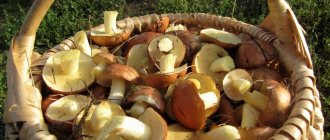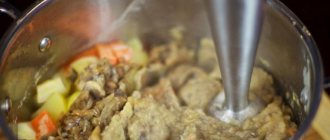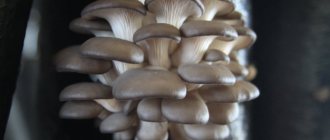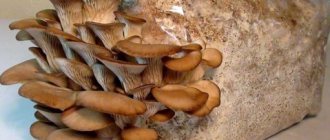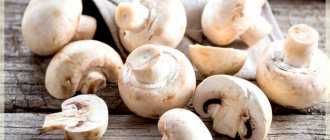Pickling is one of the most common ways to preserve food for the winter. Preservatives in this case are acetic acid, salt and sugar. And to give the preparations a pronounced aroma and piquant flavor notes, various spices are used. You can store pickled mushrooms for quite a long time, but read on to learn how to do this.
Mushrooms with a tubular structure are usually pickled. This:
- white,
- honey mushrooms,
- boletus
- boletus mushrooms
You can also preserve boletus, fat mushrooms, autumn honey mushrooms, etc. Only young and strong specimens that do not have a wormhole are collected.
Despite the presence of food preservatives, this type of preparation has its own shelf life. Therefore, you need to know how long to store pickled mushrooms so as not to endanger your health.
Marinade and its shelf life
The main component in the marinade is acetic acid. The shelf life of pickled mushrooms will depend on its quantity and concentration. And also the time it takes to prepare them.
It is not recommended to use citric acid instead of vinegar. This preservative does not have a very good effect on the taste of the products.
The marinade is prepared by boiling. High temperature affects various harmful microorganisms that are in the water, and vinegar enhances the effect. Adding sugar and salt to the marinade allows it to be stored for up to 1.5 years. It is important that the temperature is kept between + 8°C and +15°C.
If a jar of pickled mushrooms has already been uncorked, they should be consumed within 2 days.
Prevalence
True mushroom pickers do not recognize champignons as mushrooms. After all, you won’t find them in the forest, but you can easily find them on supermarket shelves. Although true gourmets still manage to find this mushroom on their own.
Champignons are saprophytes, which means they will grow in soil rich in food. This could be rotten tree bark, humus or manure.
There are five main types of this mushroom:
- Growing only in the forest.
- Grows only among herbs.
- Saprophytes of open spaces.
- Desert (halophytes).
- Mixed (growing among herbs and in open spaces).
Most often, this lamellar mushroom can be found in Eurasia, Africa and Australia.
Storage of industrial products
If the preparations are purchased in a store, you need to know that manufacturers use types of pickling that allow their products to be stored for up to 2 years. Special additives that are used in production are not available at home. Therefore, such products are considered safer than home canning.
- Purchased pickled mushrooms are stored at a temperature not exceeding +18°C. The shelf life of the products is usually indicated by the manufacturer on the lid or label.
As for salted mushrooms, their shelf life is significantly shorter than pickled mushrooms. Even if they have been factory-salted, they must be consumed within 6 to 12 months.
Dangerous treat
Warm and humid summers are conducive to mushroom picking. But every year there are reports of victims made by silent hunting. The body signals mushroom poisoning with the following symptoms:
- stomach ache;
- vomiting or diarrhea;
- strong thirst;
- muscle spasms and cramps;
- disruption of the heart;
- excessive excitement;
- rave;
- greatly dilated pupils.
In such circumstances, you should call a doctor, even if the symptoms of poisoning stop for a while.
Before his arrival, rinse your stomach by drinking several glasses of salt water, which should induce vomiting. Do not drink milk or alcohol. Remains of vomit or food should be saved for laboratory diagnostics to identify the bacteria that caused the poisoning. It must be remembered that gastric lavage a few hours after eating a mushroom dish is no longer effective, and often only then do symptoms of poisoning appear.
Mushrooms are not valued by nutritionists because they consist mainly of water and have the ability to absorb heavy metals. In addition, they are difficult to digest. They are disliked due to the short shelf life of food prepared from mushrooms and the high probability of poisoning due to toxic substances during long-term storage in the refrigerator. However, there is no such force that could scare away gourmets from fried butter with onions, pickled chanterelles and aromatic mushroom sauce made from porcini mushrooms.
Salted mushrooms: how to store at home
Mushrooms are a perishable product. They, like all plants, die and deteriorate in the absence of food. This process cannot be stopped. As the mushroom dies, it begins to produce toxic emissions that are very dangerous for people. But the initial stage of decay is very difficult to recognize. When a buyer goes to the supermarket and buys white lumps of champignons, he does not pay attention to their appearance.
It is believed that the products in the store are fresh and safe. But this is far from true. Mushrooms begin to deteriorate a few hours after entering a warm room. Therefore, when choosing oyster mushrooms or champignons, pay attention to how they look. With brown spots on the cap, black grille and mucus, unfit for consumption.
Dried mushrooms are best suited for long-term storage . They are used in traditional cuisine and have their own circle of loyal admirers. They are used to prepare soups and stews, stewed and fried with onions, and pickled. Before drying, they must be thoroughly wiped; it is not advisable to wet them. Cut into pieces and hang over a gas burner using a string. This procedure will allow you to get rid of insects that were missed when inspecting the mushrooms. Place the dried mushrooms in an airtight container.
Fans of savory snacks, in order not to pay attention to the shelf life of pickled mushrooms, make them from dried ones. To do this, dry mushrooms are soaked in water, boiled in a marinade and eaten as a snack.
Frozen boletus mushrooms retain their color, aroma and taste well. Before freezing, cut them into small pieces and cook for ten minutes in lightly salted water. Once ready, cool, place in plastic bags or containers and place in the freezer. You can successfully prepare the same dishes with defrosted mushrooms as with fresh ones. Due to the fact that the shelf life of pickled mushrooms at home is limited, they can be pickled in the winter after being frozen.
Freezing raw mushrooms for the winter
Pickling is another way to store mushrooms, which make an ideal appetizer. The marinade is prepared on a vinegar basis. Mushrooms in jars are a very good and convenient option. In winter, just open the jar, rinse the mushrooms from the brine and you can fry them with onions. You can use them for casseroles, pizza, or as a side dish for other dishes. They taste great, and that’s why experienced housewives make mushroom preparations this way.
Mushrooms are a universal product. They can equally be used for both the first course and the second or appetizer. Due to the development of exports, in addition to the familiar mushrooms - chanterelles and porcini mushrooms - there are many previously unseen species in stores. They are presented in a large assortment:
- pickled;
- dried;
- frozen;
- canned.
They are also supplied from other countries. Of course, this product cannot be stored for a long time. As you know, the main danger of mushrooms is poisoning. To prevent this from happening, you need to use industrially produced pickled products.
But, as you know, during mushroom season people make mushroom preparations for the winter. Home conservation carried out in violation of technology is a risk factor. To prevent pickled products from causing poisoning, you must adhere to the following rules:
- Use only those mushrooms that are familiar.
- Before processing, rinse them thoroughly to remove dirt and sand.
- Boil in salted water for at least 50 minutes.
- Do not seal pickled mushrooms hermetically.
- Do not store for a long time even in the refrigerator.
- The marinade should have an acidity of 1.5%.
- Sterilize products for at least 30 minutes.
- Seal only with sterilized caps.
Canned honey mushrooms are prepared as follows. They are pre-boiled in salted water for 20 minutes. Fry in a frying pan in a large amount of fat. Place in sterile jars and fill with melted butter or lard. Experienced housewives know how long canned mushrooms can be stored, but it is advisable to consume them within 4 months. Be sure to fry for 15 minutes before eating.
How to dry porcini mushrooms for the winter at home
Storage conditions for pickled mushrooms
It is important to know not only the shelf life, but also the conditions under which pickled mushrooms will retain their quality for as long as possible.
Products preserved in marinade should be kept in a cool place where the temperature is around + 8°C and where the sun's rays do not penetrate. A cellar or basement is well suited for these purposes. You can keep the preparations in the refrigerator, but here everything depends on the number of sealed jars.
To extend the shelf life of home-canned food up to 2 years, you can use more vinegar when preparing it. It will prevent the development of harmful microorganisms in mushrooms, and thereby extend their shelf life.
How long can pickled mushrooms be stored?
The shelf life of mushrooms in the marinade is also affected by the temperature of the room in which the preparations are located. The higher it is, the faster the product will deteriorate.
- In a cool room, where the temperature does not exceed + 18°C, mushrooms will last up to 1 year.
- When stored at temperatures from +8 to +18 °C, the preservation will last about one and a half years.
- In a refrigerator or other room at a temperature of 0 to +8°C, the shelf life will be from one and a half to 2 years. Provided that the marinade completely covers the mushrooms.
If the jar is already open, even on the refrigerator shelf, mushrooms can be stored for no more than 2 weeks.
Other site materials
How long to store dumplings
In Siberia, dumplings are made in whole bags and stored all winter. Find out how long you can store ready-made dumplings in the refrigerator
How long does protein last?
Whites sometimes remain after cooking various dishes... Introducing our new article on storing chicken egg whites
Pickling mushrooms is a common and reliable way to preserve the harvest.
Homemade preparations are not only tasty, but also convenient to use. You can prepare many different dishes with salted mushrooms. In this article we will talk about how to properly store salted mushrooms.
Source: depositphotos.com
How are pickled mushrooms stored?
The preparations are kept in containers that do not oxidize under the influence of vinegar. These are enamel dishes, clay and tinned. But the best way is to store pickled mushrooms in glass jars. This storage method is recommended by GOST. The only thing you need to do is remove them away from sunlight.
To prevent oxidative reactions of the marinade from occurring when it interacts with air, the container is filled with sterilized vegetable oil on top.
Undesirable oxidative processes can occur if the jar is sealed with a metal lid. When metal interacts with the contents, toxic substances are formed, which, exceeding the permissible limit, can cause poisoning.
During the marinating process, you should strictly adhere to established recipes. Otherwise, botulism toxin may form in the products, which develops in sealed containers. This poison is fatal in most cases. Therefore, if you are not confident in your capabilities, it is better not to engage in conservation at all.
If mold forms on the surface, it is better to immediately throw away the contents of the jar, since even repeated boiling of mushrooms can lead to the formation of botulinum toxins in the future.
Security questions
The relevance of the issue is due to the fact that in hermetically sealed jars with mushrooms, the life-threatening bacterium botulism develops, causing severe poisoning. It is impossible to determine this by eye, but proper canning and storage allows you to be sure of safety.
If mushrooms are not stored under a tight lid, then other types of bacteria and mold can develop in them. This makes the product bitter or too sour and also hazardous to health.
To store mushrooms at home, you can use sterilized glass, enamel or ceramic containers.
Tubular mushrooms are best suited for pickling - boletus, boletus, boletus. But some lamellar mushrooms are also excellent at pickling, for example, honey mushrooms and greenfinches. Greenfinches should be treated with caution and consumed in moderation, since this mushroom is conditionally edible. Whenever you do your own preservation, you need to be sure that the mushrooms are edible.
What does it depend on?
Why are mushrooms classified as perishable foods?
The fact is that, like any plant substance , without receiving nutrition, fresh champignon, for example, begins to die, or in other words, to deteriorate.
This process is almost impossible to stop.
As it dies, the fungus begins to secrete toxic secretions , which are very dangerous for humans. However, the initial stage of decay is very difficult to recognize.
When we go to the supermarket and pick ourselves up white lumps, we don’t pay attention to their appearance . It seems to us that since they are allowed to be sold, it means they are harmless. However, this is not the case.
In fact, the mushroom may begin to disappear after a few hours of being in a room at room temperature. It is very difficult for an ignorant person to determine whether it is fresh or not.
To give an example of champignons, when they begin to rot, they first become covered with brownish spots and become slimy . However, this does not prevent customers from purchasing the product with confidence.
This initial stage is not so scary if the mushrooms are processed at high temperatures , for example, in the oven or in a frying pan. Under no circumstances should they be eaten raw or half-raw .
Why does the rotting process ? Firstly, because the time has come, and the mushrooms have been in the room for a long time and their shelf life is coming to an end.
Secondly, these are incorrect storage conditions . Unsealed containers for these products, moisture ingress, or storage in aluminum containers, which causes early oxidation.
Let us next consider the shelf life of mushrooms by category.
Dried
Dried mushrooms came to us from China. In the land of the rising sun, they were collected and dried in dry rooms. Drying continued until practical mummification , only then they could be eaten.
This was done because these products in China are extremely poisonous , and only some types can be eaten. During the drying process, the poison evaporates and the mushrooms become edible.
China began mass supply after the collapse of the Soviet Union and continues to this day.
However, in Rus' they were also dried by hanging them in the corners of huts.
Today, dried mushrooms are added to soups and other liquid dishes. They add incredible taste and are pleasant to eat.
How long do such products last and when should you sound the alarm when you see an unsightly date on the packaging?
As a rule, depending on processing, containers and packaging can be stored for more than a year . However, you should not buy dry mushrooms that have a slightly longer shelf life. The fact is that the more time passes, the less protein remains in them, which means that the beneficial properties are lost over time . Recommended storage period is one year.
Pickled
Marinated mushrooms are a special product . They have a very specific taste, which allows them to be eaten both separately and as part of complex dishes.
You can pickle any non-poisonous species, and the amount of marinades can be very different. Pickled mushrooms can be offered both by large factories and companies, and by grandmothers in markets.
Of course, we know for sure that goods purchased on the market are much more natural than those packaged in factories, however, in the event of poisoning, you are unlikely to be able to hold anyone accountable
In addition to the shelf life, you need to pay attention to the storage conditions. Products should be on dark shelves and under no circumstances in direct sunlight.
They must be located according to GOST - in a glass container or, simply, in a jar. The lid that closes the jar plays an important role.
Depending on the material used in the manufacture
of the lid , it significantly affects the condition of the mushrooms.
So, in jars with metal lids they are stored for one year , and in jars with glass lids - for two years .
The fact is that glass is not toxic and therefore can easily come into contact with food products throughout their entire shelf life without harming our body, but metal can oxidize food, thereby harming your health .
Canned
Canned mushrooms are a common ingredient in salads, baked goods and some other dishes. The advantage of preserves is that they practically do not change and retain their original, original taste, unlike pickled ones.
They undergo thorough heat treatment , preserved in a special solution and carefully sealed. All these procedures must be done correctly and carefully , because they directly affect the shelf life. Thus, if all the rules and conditions are met, the shelf life of one jar can be up to five years .
However, not every manufacturer takes the responsibility to carefully monitor the preparation and packaging process, therefore, in order to avoid unpleasant consequences, purchase canned mushrooms only in tin, not deformed cans , with a shelf life of no more than three years.
Terrible disease botulism
Sausage poison (botulinum toxin) is one of the most powerful poisons. It affects muscles, causes vomiting, abdominal pain, makes swallowing difficult, and impairs vision. One of the reasons is improperly prepared canned mushrooms. The toxin is produced in the soil, so poorly washed mushrooms cause the development of bacteria. Fortunately, bacteria are killed at temperatures above 130 degrees. Therefore, to be on the safe side, the canned food must be fried for 10 minutes.
Several mechanisms of neurotoxin poisoning are known. The most common is the accidental penetration of bacterial spores into the human body through the gastrointestinal tract. Spores are often found in foods that are packaged without access to air. Botulism occurs after eating contaminated and improperly stored canned food. Sausage poison can occur in meat and semi-finished products if they are not stored correctly, especially in the summer.
Botulism can affect the body as a result of consuming canned mushrooms, which are usually not suspicious in terms of appearance, smell or taste. In cans affected by botulism bacteria, gas is released, which causes so-called bombing, that is, visible swelling of the upper and lower parts of the can, and is manifested by hissing gas when trying to open the can.
How to freeze fresh champignons in your home refrigerator
For symptoms of poisoning to appear, only 0.001 mcg/kg of body weight is affected by botulinum toxin. The lethal dose for a man weighing 70 kg is 70 mcg in terms of pure toxin. Clinical symptoms usually appear within 12 hours, but this time can range from 2 hours to 14 days:
- nausea, vomiting and diarrhea;
- visual impairment - blurred vision or diplopia;
- symmetrical paralysis or damage to the cranial nerves, prolapse of the lower jaw, difficulty swallowing and slurred speech;
- descending flaccid paresis of the limbs with damage to the muscles of the chest and diaphragm, which leads to respiratory failure;
- dryness of the mucous membranes of the oral cavity and pharynx;
- conjunctival hyperemia;
- pastoral hypotension;
- decreased blood pressure;
- urinary disorders.
Diagnosis of poisoning is based on the presence of neurotoxin in the blood serum or stool. Therefore, if you have symptoms, you should consult a doctor as soon as possible. People in good general condition are given a laxative and serum is injected. If the function of the respiratory muscles deteriorates, artificial respiration is used. If help does not arrive in time, death may occur.


